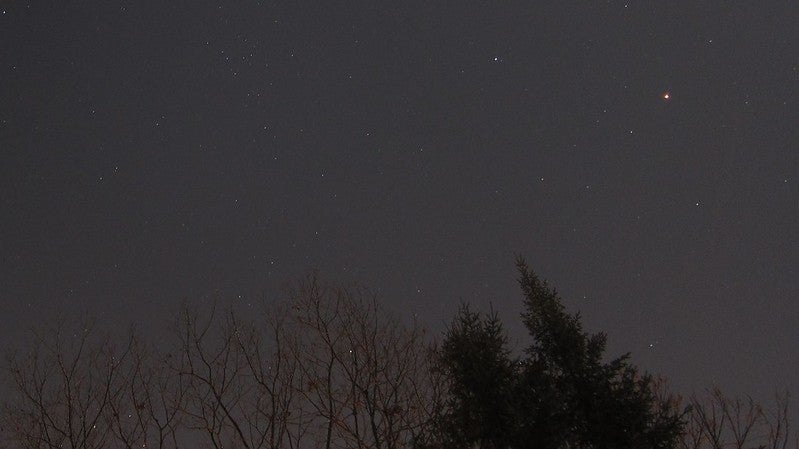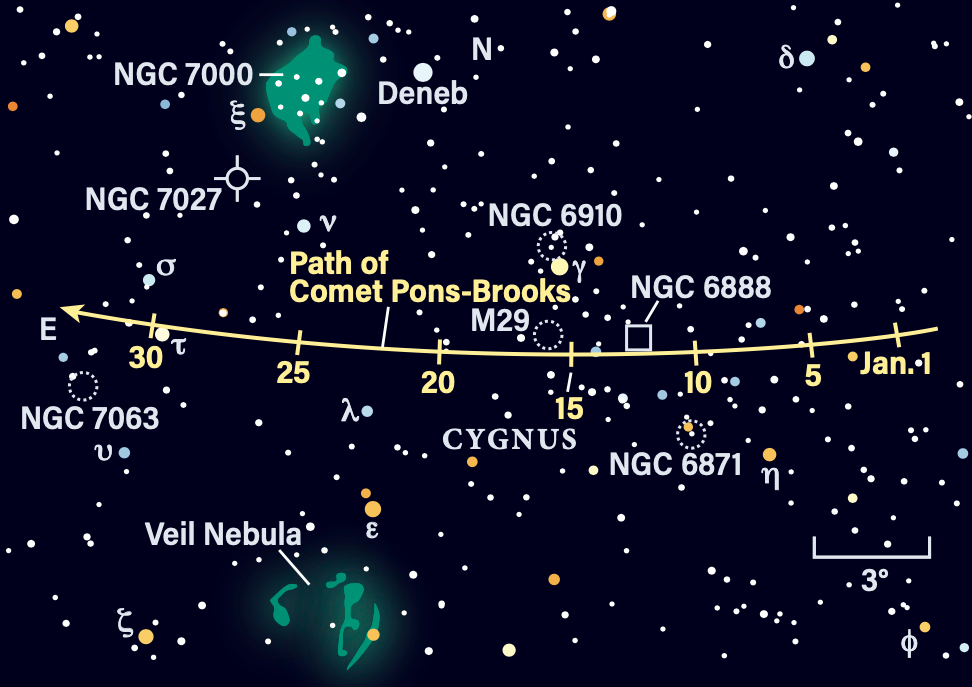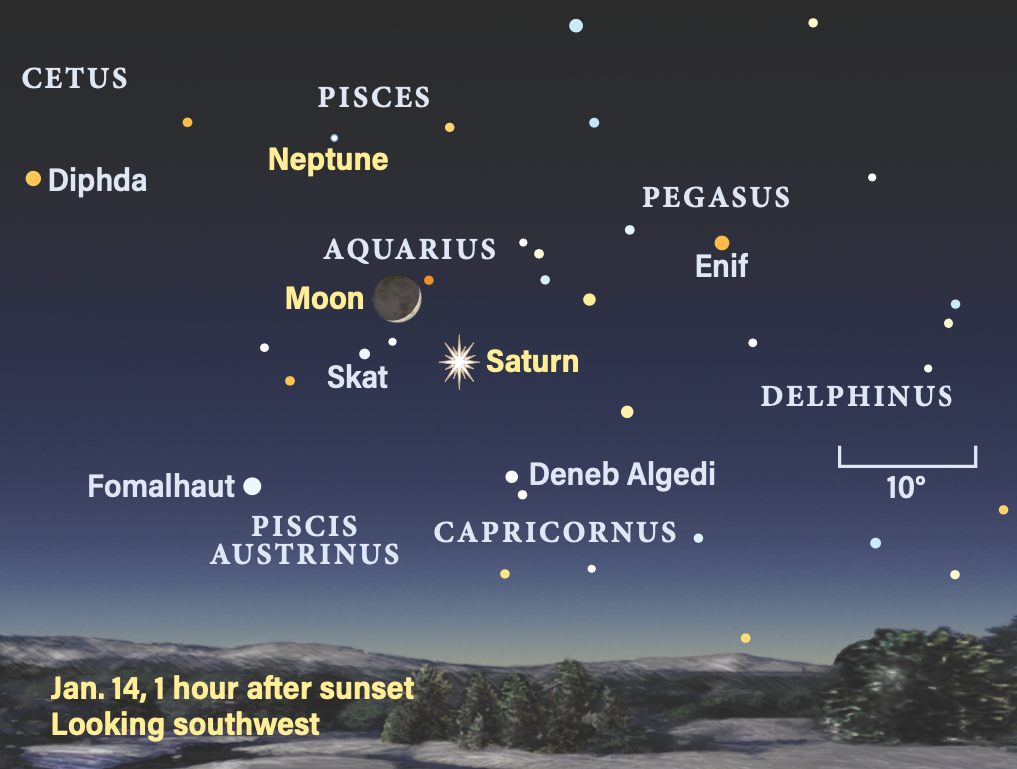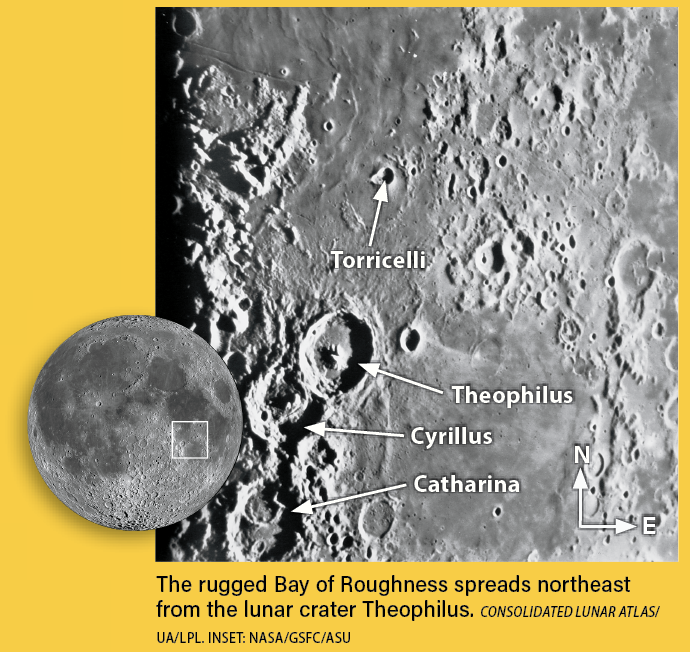
Friday, January 12
Mercury reaches its greatest western elongation (24°) from the Sun at 10 A.M. EST this morning.
In the evening sky, Comet 12P/Pons-Brooks is setting in the west with the stars of Cygnus. You can catch it an hour or two after sunset — note that the earlier, the better! — skimming some 0.5° southeast of the Crescent Nebula (NGC 6888). You can find them both just under 2° southwest of magnitude 2.2 Sadir (Gamma [γ] Cygni).
Pons-Brooks has been recently recorded at magnitude 8.8 and is slowly brightening, so the Crescent will be the more challenging of the two, particularly at low power. This large, diffuse emission nebula stretches about 18′ at its widest and is best seen with an OIII filter to help bring out its glow. Fortunately, the Moon won’t interfere tonight, so although the region is setting early and you’ll want to get your scope set up as soon as possible after sunset, you won’t have to worry too much about background light — particularly if you can get to a site with a clear, city-free western horizon.
In addition to the Crescent Nebula, Cygnus is a rich constellation full of deep-sky wonders; check out the star chart below to help you locate both Comet Pons-Brooks and several other targets to seek with your telescope tonight.

Sunrise: 7:21 A.M.
Sunset: 4:56 P.M.
Moonrise: 8:42 A.M.
Moonset: 6:23 P.M.
Moon Phase: Waxing crescent (2%)
*Times for sunrise, sunset, moonrise, and moonset are given in local time from 40° N 90° W. The Moon’s illumination is given at 12 P.M. local time from the same location.
Saturday, January 13
The Moon reaches perigee — the closest point to Earth in its orbit — at 5:36 A.M. EST. At that time, our satellite will sit 225,102 miles (362,267 kilometers) from Earth.
Tonight, Europa and Ganymede are repeating their transit from last week. If it’s dark from your location, try to tune in around 7 P.M. EST, before the event begins. Far to the planet’s east is Callisto; Europa and Ganymede (the former farther out) sit close to Jupiter’s eastern limb. Io is alone to the west.
Keep watching through your telescope and you’ll spot Europa start to transit just before 7:40 P.M. EST. At the same time, keep an eye on the western limb: Io disappears behind it within a minute or so of Europa’s transit start. Just minutes later, Ganymede finally crosses onto the cloud tops south of the smaller moon.
About two hours later, the two moons leave the disk one after another as well: Ganymede slips away around 9:45 P.M. EST, while Europa’s transit has ended by 10 P.M. EST. At this time, Io is embedded in Jupiter’s long, dark shadow, even though it has fully crossed behind the planet. It won’t reappear until just over an hour later, far to Jupiter’s east.
If you’re able, keep an eye out for Europa’s shadow, which starts its own transit from east to west around 10:15 P.M. EST. It disappears around 12:35 A.M. EST on the 13th (still late on the 12th in all other U.S. time zones). And it takes Ganymede’s shadow another hour to even appear, crossing much farther south than Europa’s. Observers in the eastern half of the U.S., see how long you can follow it before the planet sinks too low or sets.
Sunrise: 7:21 A.M.
Sunset: 4:57 P.M.
Moonrise: 9:19 A.M.
Moonset: 7:43 P.M.
Moon Phase: Waxing crescent (7%)

Sunday, January 14
The Moon passes 2° south of Saturn at 5 A.M. EST. You can catch the pair in the evening sky, with Saturn glowing at magnitude 0.9 and just over 20° high in the southwest amid the faint stars of Aquarius an hour after sunset. The delicate crescent Moon lies to the planet’s upper left, now about 7.5° to Saturn’s east in the sky. Our satellite is located near Aquarius’ 3rd-magnitude delta star, Skat.
Look closer to the horizon, to the lower left of the Saturn-Moon pair. You may spot a bright star some 10° high — this is Fomalhaut in Piscis Austrinus. This magnitude 1.2 star is the 18th brightest star in the sky. It’s a young sun well known for the disk of dusty debris around it, inside which astronomers believe planets are slowly forming.
If you’re up for some binocular or telescope observing, you can also catch distant Neptune in the evening sky, hanging above the Moon. The ice giant lies at the border of Pisces and Aquarius, nearly 14° above the Moon and about 5° south of Lambda (λ) Piscium, the southeasternmost star in Pisces’ Circlet asterism. Neptune glows a faint magnitude 7.8, only accessible with optical aid. The Moon, moving along the ecliptic, will pass close to the solar system’s farthest planet tomorrow afternoon.
Sunrise: 7:21 A.M.
Sunset: 4:58 P.M.
Moonrise: 9:49 A.M.
Moonset: 9:00 P.M.
Moon Phase: Waxing crescent (15%)
Monday, January 15
Asteroid 3 Juno stands stationary against the stars of Leo at 6 A.M. EST this morning. At that time, Leo is well above the horizon and early-morning observers should be able to easily spot the Sickle asterism anchored by the Lion’s heart, magnitude 1.4 Regulus.
Juno sits in the far southwestern portion of the constellation, about 7.5° south of magnitude 4.1 Sigma (σ) Leonis. The large main-belt word is magnitude 9.3, reachable with large binoculars or a small scope. You’ll find it just 17′ northeast of a 7th-magnitude field star. Over the past week, Juno passed south of this star and has now swung around to its northeast. After tonight, Juno will begin tracking northwest, heading roughly in the direction of Regulus.
The Moon passes 0.9° south of Neptune at 3 P.M. EST. By 7 P.M. EST (when it is dark for the eastern half of the U.S.), our satellite lies 1.6° east of the planet, offering a good signpost to help locate the distant world through your binoculars or telescope.
Sunrise: 7:20 A.M.
Sunset: 4:59 P.M.
Moonrise: 10:15 A.M.
Moonset: 10:14 P.M.
Moon Phase: Waxing crescent (24%)

Tuesday, January 16
Turn your telescope toward the waxing Moon this evening to observe some of the fine detail on its rugged surface. In the lunar east are several round, dark maria or seas, though they are actually ancient flows of lava. These seas also contain bays, and tonight we’re homing in on the Bay of Roughness, also called Sinus Asperitatis, on the southern edge of the Sea of Tranquillity, connecting it to the nearby Sea of Nectar.
Using the chart above, start at the 60-mile-wide (97 km) crater Theophilus. Check out its central peak, a feature that often forms in impact craters. Look just north of the crater’s rim, too — can you spot the debris from the impact that created it, spread across the terrain? Just south of Theophilus is Cyrillus, and south of that is Catharina. This chain of craters also reveals a chain of events: Theophilus is youngest, with Cyrillus slightly older, and Catharina the oldest of the three.
Move north again and you’ll land in a tiny double pockmark called Torricelli. Just one impactor formed this strange structure, blasting through the forming wall of the crater just after it hit. Compare it with Messier A in the Sea of Fertility to the east, which was created (along with its partner Messier) in a similar fashion, though this time by a single impactor striking at a shallow angle and breaking up.
Sunrise: 7:20 A.M.
Sunset: 5:00 P.M.
Moonrise: 10:40 A.M.
Moonset: 11:27 P.M.
Moon Phase: Waxing crescent (34%)
Wednesday, January 17
Venus and Mercury have been slowly approaching each other in the morning sky. Today they stand at their closest, with about 11° between them. Mercury lies east of Venus, sitting to the brighter planet’s lower left in the sky. After today, Mercury will appear to “fall” back toward the Sun, getting lower in the sky but brightening as it does so.
An hour before sunrise this morning, look southeast to find magnitude –4 Venus about 12° high. Mercury is 4° high and a much fainter (though still respectable) magnitude –0.2. Through a telescope, Venus shows off a 13″-wide, 82-percent-lit gibbous disk. Mercury spans just 6″ and is 73 percent lit.
To Venus’ upper left is the constellation Ophiuchus. Its alpha star, called Rasalhague, is a rather unimpressive magnitude 2.1. But to the left of this constellation is a bright trio: the mighty Summer Triangle, which rises in the morning at this time of year and becomes invisible in the light of day. Closest to the horizon is Altair in Aquila the Eagle; to its upper left is Deneb in Cygnus the Swan, while to Deneb’s upper right and highest of the Triangle’s three points is Vega in Lyra the Lyre.
The waxing Moon reaches its First Quarter phase late tonight at 10:53 P.M. EST.
Sunrise: 7:20 A.M.
Sunset: 5:01 P.M.
Moonrise: 11:04 A.M.
Moonset: —
Moon Phase: Waxing crescent (46%)
Thursday, January 18
The Moon passes 3° north of Jupiter at 4 P.M. EST. Half an hour after sunset, the two stand high in the southeastern sky, still roughly the same distance apart. Jupiter glows at magnitude –2.5, making it the first point of light to pop out against the falling darkness. Keep a close watch on the region to the lower right of the Moon to see when it appears to your eyes. To the lower left of the pair, the brightest stars in Taurus and Orion should soon start appearing as well.
The waxing gibbous Moon is bright but fortunately, so is Jupiter, meaning the nearby light of Luna won’t interfere with observing the planet too much. Through a telescope, Jupiter’s disk spans some 41″ and all four of its Galilean moons are visible. But depending on your time zone and when you observe, their configuration might change, as Ganymede passes Callisto to Jupiter’s east and Europa passes Io to the west.
Observers on the East Coast of the U.S. who observe close to sunset might see Ganymede just slightly northeast of Callisto on Jupiter’s eastern side, with the former closer to the planet. Around 5:15 P.M. EST, the two stand in a vertical line, with Ganymede due north of Callisto. After this, Ganymede pulls farther east, while Callisto moves west, putting it closer to the planet for the rest of the night.
Meanwhile, on Jupiter’s western side, Europa starts the evening northwest of Io, with the latter closer to the planet. Around 8:50 P.M. EST, Europa passes due north of Io, afterward moving eastward and closer to Jupiter while Io moves westward, farther from the planet.
As an additional treat, the Great Red Spot is on view tonight, passing the planet’s central meridian around 10 P.M. EST.
Sunrise: 7:19 A.M.
Sunset: 5:02 P.M.
Moonrise: 11:30 A.M.
Moonset: 12:38 A.M.
Moon Phase: Waxing gibbous (57%)
Friday, January 19
After a bit of a hiatus as it passed through solar conjunction, Mars is returning to the sky. This morning could be your first chance to spot it in the southeast before sunrise, just 5° from brighter Mercury. The pair sits about 13° east of blazing Venus, still magnitude –4 and the brightest point of light in the early-morning sky. Earth’s sister planet will remain visible even as everything else fades away in the rising dawn.
If you want to spot Mars, start your search about 45 minutes before sunrise, when Mercury, shining at magnitude –0.2, is about 6° high. Mars lies 5° to Mercury’s east (lower left on the sky) and is a mere 2° above the horizon. The Red Planet is much fainter as well, only magnitude 1.3. Use binoculars or a small scope to skim down and left from Mercury’s light; a clear southeastern horizon is needed as well, with Mars so low. Remember to put away any optics well before sunrise at your location.
Mercury and Mars will close in on each other over the next week or so, standing just 15′ apart later this month. We’ll be sure to highlight that event when it occurs.
Later today, the Moon passes 3° north of Uranus at 3 P.M. EST. We’ll catch up with them in the evening sky next week.
Sunrise: 7:19 A.M.
Sunset: 5:03 P.M.
Moonrise: 11:59 A.M.
Moonset: 1:50 A.M.
Moon Phase: Waxing gibbous (67%)

Sky This Week is brought to you in part by Celestron.









